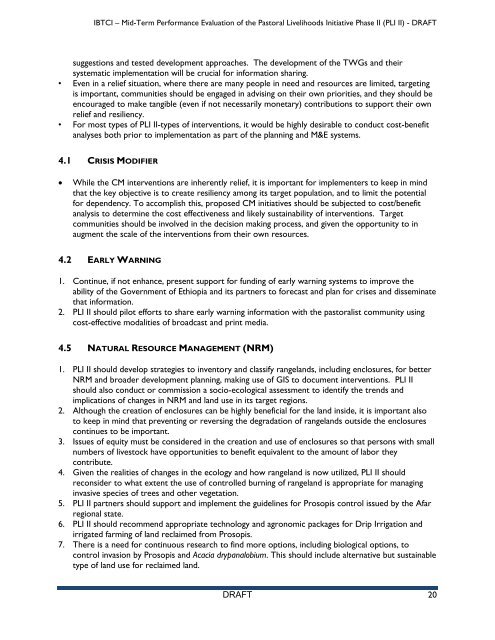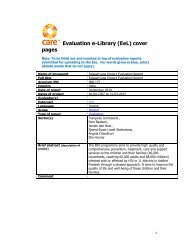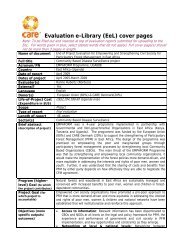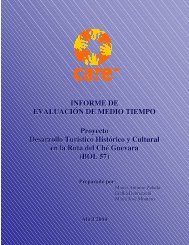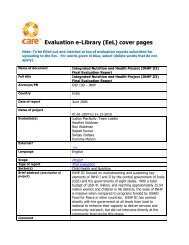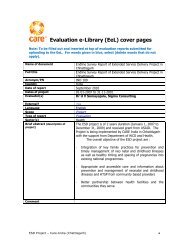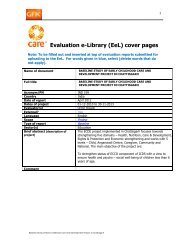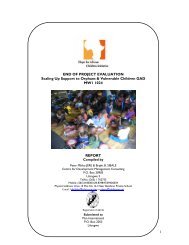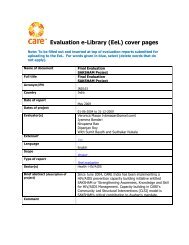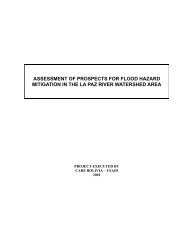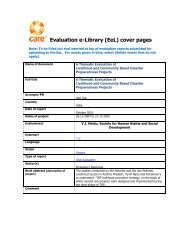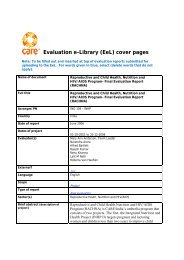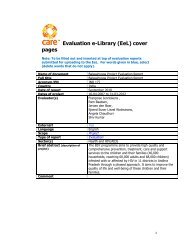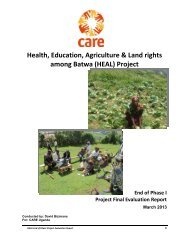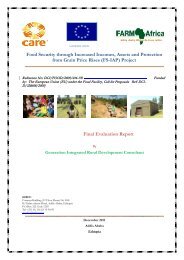Mid Term EVALUATION PLI II project - CARE International's ...
Mid Term EVALUATION PLI II project - CARE International's ...
Mid Term EVALUATION PLI II project - CARE International's ...
You also want an ePaper? Increase the reach of your titles
YUMPU automatically turns print PDFs into web optimized ePapers that Google loves.
IBTCI – <strong>Mid</strong>-<strong>Term</strong> Performance Evaluation of the Pastoral Livelihoods Initiative Phase <strong>II</strong> (<strong>PLI</strong> <strong>II</strong>) - DRAFT<br />
suggestions and tested development approaches. The development of the TWGs and their<br />
systematic implementation will be crucial for information sharing.<br />
• Even in a relief situation, where there are many people in need and resources are limited, targeting<br />
is important, communities should be engaged in advising on their own priorities, and they should be<br />
encouraged to make tangible (even if not necessarily monetary) contributions to support their own<br />
relief and resiliency.<br />
• For most types of <strong>PLI</strong> <strong>II</strong>-types of interventions, it would be highly desirable to conduct cost-benefit<br />
analyses both prior to implementation as part of the planning and M&E systems.<br />
4.1 CRISIS MODIFIER<br />
• While the CM interventions are inherently relief, it is important for implementers to keep in mind<br />
that the key objective is to create resiliency among its target population, and to limit the potential<br />
for dependency. To accomplish this, proposed CM initiatives should be subjected to cost/benefit<br />
analysis to determine the cost effectiveness and likely sustainability of interventions. Target<br />
communities should be involved in the decision making process, and given the opportunity to in<br />
augment the scale of the interventions from their own resources.<br />
4.2 EARLY WARNING<br />
1. Continue, if not enhance, present support for funding of early warning systems to improve the<br />
ability of the Government of Ethiopia and its partners to forecast and plan for crises and disseminate<br />
that information.<br />
2. <strong>PLI</strong> <strong>II</strong> should pilot efforts to share early warning information with the pastoralist community using<br />
cost-effective modalities of broadcast and print media.<br />
4.5 NATURAL RESOURCE MANAGEMENT (NRM)<br />
1. <strong>PLI</strong> <strong>II</strong> should develop strategies to inventory and classify rangelands, including enclosures, for better<br />
NRM and broader development planning, making use of GIS to document interventions. <strong>PLI</strong> <strong>II</strong><br />
should also conduct or commission a socio-ecological assessment to identify the trends and<br />
implications of changes in NRM and land use in its target regions.<br />
2. Although the creation of enclosures can be highly beneficial for the land inside, it is important also<br />
to keep in mind that preventing or reversing the degradation of rangelands outside the enclosures<br />
continues to be important.<br />
3. Issues of equity must be considered in the creation and use of enclosures so that persons with small<br />
numbers of livestock have opportunities to benefit equivalent to the amount of labor they<br />
contribute.<br />
4. Given the realities of changes in the ecology and how rangeland is now utilized, <strong>PLI</strong> <strong>II</strong> should<br />
reconsider to what extent the use of controlled burning of rangeland is appropriate for managing<br />
invasive species of trees and other vegetation.<br />
5. <strong>PLI</strong> <strong>II</strong> partners should support and implement the guidelines for Prosopis control issued by the Afar<br />
regional state.<br />
6. <strong>PLI</strong> <strong>II</strong> should recommend appropriate technology and agronomic packages for Drip Irrigation and<br />
irrigated farming of land reclaimed from Prosopis.<br />
7. There is a need for continuous research to find more options, including biological options, to<br />
control invasion by Prosopis and Acacia drypanalobium. This should include alternative but sustainable<br />
type of land use for reclaimed land.<br />
DRAFT 20


